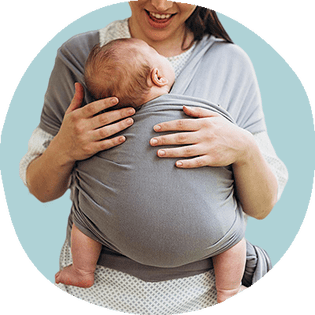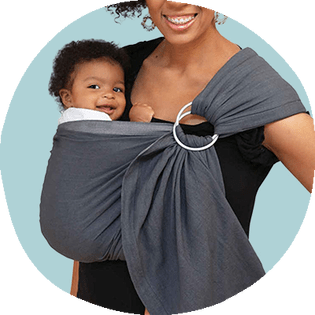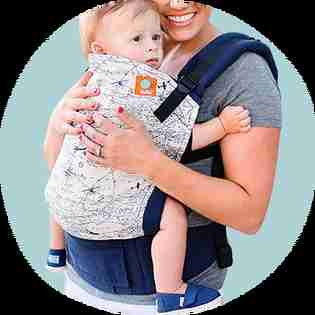We include products we think are useful for our readers. If you buy through links on this page, we may earn a small commission. Here’s our process.
Your little one was carried for 9 long months in the womb. While that may sometimes have been a challenge for the person doing the carrying, your baby was likely pretty happy with their cozy digs.
Since babies tend to know what they like (and let you know, loudly) some parents choose to continue carrying their infants in the fourth trimester (newborn days) all the way to the toddler years (and sometimes beyond).
While babywearing may seem trendy, it’s actually been practiced for thousands of years. These days, there are a number of baby carriers on the market — indeed, it can be overwhelming if you’re not familiar with all the styles and terms.
Don’t worry, though, because you can’t necessarily go wrong. To be sold and marketed, baby carriers must meet certain safety criteria set forth by the U.S. Consumer Product Safety Commission and other organizations.
Safety note
Some carriers can be used multiple ways, including:
- front, facing inward
- front, facing outward
- back
- hip
Until they’re about 3 to 6 months old and have good neck control, babies should only be worn on the front, facing inward. After that, you can try other positions.
So it’s just a matter of finding the right one for you. That’s where we come in.
Related: Guide to babywearing: Benefits, safety tips, and how to
Knowing that all carriers are technically safe, choosing the best one comes down to your lifestyle, budget, body, and — of course — your baby.
The following carriers get good marks from caregivers we consulted and in reviews for being easy to use, durable, and adaptable to different needs and carrying positions.
Note: There are some limitations to this list because reviews are subjective and may reflect opinions that you might not necessarily share. Still, we hope our picks will give you a good starting point for finding the carrier that’s ideal just for you and your precious cargo!
Soft wraps and ring slings may be a simpler choice than some other types of carriers, as they have fewer buckles and adjustments.
Even though they seem basic, it’s important to thoroughly read and follow instructions, as they can pose risks if used incorrectly, especially for babies younger than 4 months.
Boba Wrap

- Price: $
- Weight range: Up to 35 lbs.
- Material: Cotton and spandex
- Baby Position: Front, facing inward
Key features: This inexpensive wrap is a bestseller that comes in a rainbow of colors. While you can use this wrap with infants from birth, it’s also handy for toddlers up to 35 pounds. It’s made from 95 percent cotton for breathability and has 5 percent spandex for some stretch and hold. This wrap comes in one-size-fits-all that may be helpful with changing postpartum bodies and fitting other caregivers in the family.
Considerations: Soft wraps may take some time to master. There are a variety of ways to tie them, but it may be frustrating for some users — especially when out and about. Other parents share that the life of this wrap is relatively short because, despite the weight limit, they don’t find it comfortable with larger infants and toddlers.
Maya Wrap Lightly Padded Ring Sling

- Price: $
- Weight range: 8 – 35 lbs.
- Material: Cotton
- Baby position: Front, facing inward; front, facing outward; hip
Key features: A ring sling may be a better option for you if tying a wrap is intimidating. Putting it on is simple, making it a smart choice if you’re traveling or otherwise out of the house. Just place it over your shoulder, put your baby in the pouch, and gently pull the tail to adjust to size.
The Maya Wrap is padded for comfort. Plus, some reviewers note that they can easily breastfeed in this carrier.
Considerations: You’ll need to purchase this sling in the correct size for your body, which means you may not be able to share it with another parent or caregiver. While some people love the padding, others say non-padded slings may actually be more comfortable. Others yet say the fabric is too thick, making it difficult to adjust.
Toddlers are often on the move, but may still like to be carried from time to time. Good carriers may help protect your back with good ergonomic support and padding.
Tula Ergonomic Toddler Carrier

- Price: $$
- Weight range: 25 – 60 lbs.
- Material: Cotton
- Toddler position: Front, facing inward; back
Key features: This soft-structured carrier adjusts to fit a variety of body shapes and sizes. And when it gets dirty, you can just toss it in your washing machine for easy cleaning.
Considerations: At more than $100, this piece is a bit of an investment. Some reviewers don’t like that your child cannot face out in this carrier. Others say that there’s little head support for toddlers, which can be uncomfortable if they fall asleep while being carried.
Men can use any baby carrier they like, provided it fits and is comfortable. There are a few carriers on the market that may fit a male build better.
Mission Critical Carrier
- Price: $$
- Weight range: 8 – 35 lbs.
- Material: Nylon
- Baby position: Front, facing inward; front, facing outward
Key features: The body of this carrier is made from durable and lightweight nylon fabric and has a rugged military design with webbing (great for attaching toys). And the liner is removable for quick washing.
Considerations: Reviewers explain that this carrier fits even big and tall dads well, but that it can be difficult to share with another caregiver who is a different size. Some also say this carrier may not be the most comfortable for growing babies. Why? Its seat may not promote the best position, as it allows baby’s feet to dangle instead of spreading wide with lifted knees into a healthier, ergonomic shape.
Dangling legs, especially in the first few months of life, can increase the risk of hip dysplasia. When purchasing a new carrier, be sure to check the fit and make sure the base of the carrier is wide enough to support your baby’s thighs.
You’ll find carriers, particularly wraps and slings, that come in different sizes. Soft-structured carriers, on the other hand, tend to be one size with adjustable belts. The good news is that there are options made to accommodate larger bodies.
ErgoBaby Omni 360
- Price: $$
- Weight range: 7 – 45 lbs
- Material: Cotton
- Baby position: Front, facing inward; front, facing outward; hip or back
Key features: The Omni 360 is a versatile carrier that’s adjustable to fit petite to plus-sized body types. The waist belt can adjust from 26 to 52 inches and the shoulder straps can move from 28 3/4 inches to 48 3/4 inches. Along with carrying baby on the front, back, and hip, you can wear the straps backpack style or crossed. Reviewers share that the straps are nicely padded and that the material is sturdy but soft.
Considerations: A few reviewers shared that it was hard to get the hang of using this carrier with its many options. Those who are familiar with an older fabric used with this model explain that the current fabric is stiffer and doesn’t breathe well in warm weather. Shorter women say that this carrier just isn’t a good fit.
Tula Free-To-Grow Baby Carrier
- Price: $$
- Weight range: 7- 45 lbs.
- Material: Cotton
- Baby position: Front, facing inward; back
Key features: The waistband on the Free-to-Grow adjusts from 27 inches to 57 inches. No infant insert is needed — instead, you simply adjust the height setting within the carrier to fit your child. It also comes in a variety of colors and prints to suit your style.
Considerations: Some reviewers feel the fabric is too thick and hot for warm weather. Others don’t like that you can’t face baby outward in the front-carry position. And a few mention that the straps are more difficult to adjust than those of similar carriers.
Younger babies are safest when positioned on your front, facing inward. However, as your baby gets a bit older, they may not be as content facing in toward your body. Moving your baby to face outward gives them a bit more stimulation and entertainment.
Baby Bjorn Original Carrier
- Price: $
- Weight range: 8 – 25 lbs.
- Material: Cotton
- Baby position: Front, facing inward; front, facing outward
Key features: You may think of a Baby Bjorn when you think of a baby carrier. This style has been around since 1961, much longer than others you’ll find on this list. It’s a good choice for newborns because you don’t need any additional newborn insert. Reviewers like that this carrier isn’t bulky like some others on the market, and, as a result, may be more comfortable in the facing-forward position.
Considerations: Since carrier only fits babies up to 25 pounds, you’ll need to buy something new for older children. Some reviewers do not feel this carrier has enough padding to be comfortable wearing for long stretches — for parents or babies.
You may be able to get away with other baby carriers for short or easy hikes. If you’re more of a high peaks kind of adventurer, though, you might want to invest in a structured hiking pack for making trips more comfortable.
Osprey Poco
- Price: $$$
- Weight range: 16 lbs. minimum child weight, 48.5 lbs. maximum (includes any gear you may be carrying).
- Material: Nylon
- Baby position: Back
Key features: Made of durable nylon, this structured carrier has an aluminum frame for lightweight support. It has 6 inches of adjustment in the torso to fit a variety of body sizes. There’s a “halo harness” in the seat area to help secure your baby in the carrier. Your little one will also appreciate the built-in sunshade on sunny days or for extra privacy when napping. Bonus: Osprey will repair this carrier for free if it becomes damaged for any reason.
Considerations: At almost $300, this carrier is expensive. It’s important to make sure it’s properly fitted before wearing. The waist belt can dig into the hip area and even cause bruising if it doesn’t fit properly.
This carrier should only be used once your baby is old enough to hold their head up and sit up on their own. This usually happens by about 4 to 6 months of age.
Clevr Cross Country Child Carrier
- Price: $$
- Weight range: Up to 33 lbs.
- Material: Oxford cloth
- Baby position: Back
Key features: This hiking backpack is a more budget-friendly option and works for babies and toddlers between 9 months and about 4 years old. The pack itself only weighs 5 1/2 pounds and has an aluminum frame. It has padding on the straps, hip belt, and lumbar area, plus plenty of pockets for carrying water bottles, diapers, and other must-haves.
Considerations: Some reviewers appreciate the price of this carrier but say that the more expensive counterparts are worth the extra cash because they’re more comfortable and are made of better quality materials. Petite users also complain that the size of the carrier just doesn’t work for them. A few note that the backpack tends to squeak while in use.
Yes, snuggling close with your baby in a carrier can be cozy. It may also get quite warm, especially in summer weather. The good news is that companies have addressed this by making carriers from materials that breathe.
Lillebaby Complete Airflow
- Price: $$
- Weight range: 7 – 45 lbs.
- Material: Cotton and nylon
- Baby position: Front, facing inward; front, facing outward; back or hip
Key features: While the belt and straps on this soft-structured carrier are made from 100 percent cotton, the body is nylon mesh for better air circulation in hot weather. It has added lumbar support for parents and a headrest for babies.
Considerations: Some reviewers say they appreciate all the different carrying positions, but that it’s hard to figure out how to do them all. Others say that it’s not the best carrier for people who have short torsos.
Baby K’Tan Active Wrap
- Price: $
- Weight range: Up to 35 lbs.
- Material: Polyester
- Baby position: Front, facing inward; front, facing outward; hip
Key features: This wrap wicks away moisture and sweat to keep you and baby cool. The fabric also blocks 90 percent of UVA and UVB rays. While it’s technically a wrap, you don’t actually have to tie it in any special way. Instead, the K’tan simply slips over your head and is worn like a T-shirt.
Considerations: You’ll need to choose the appropriate size, from XS to XL, to get the best fit with this carrier. This means you cannot necessarily easily share it between caregivers. Some reviewers share that the fabric may not hold up well over time. Others explain that this carrier is best used with small babies and can be uncomfortable as they grow.
Don’t have a ton of money to spend on a carrier? Or maybe you want to buy a few types without breaking the bank. That’s OK. There are some good options that come in well under $50.
Infantino Flip 4-in-1 Convertible
- Price: $
- Weight range: 8 – 32 lbs.
- Material: Polyester and cotton
- Baby position: Front, facing inward; front, facing outward; back
Key features: This best-selling carrier costs around $30 and allows you to hold baby in four different ways: facing in (newborn and infant), facing out, and back carry. While it’s machine washable, it also includes a “wonder cover” that’s a bib to protect the carrier from spit-up and other messes.
Considerations: Reviewers share that this carrier has less padding than its more expensive counterparts. Others note that the straps and clips that are near baby’s face are rough and uncomfortable. In general, people say it’s a solid choice; however, if you want something to use beyond the first year and for longer stretches of carrying, you may want to spend more for a different brand.
Evenflo Breathable Carrier
- Price: $
- Weight range: 7 – 26 lbs.
- Material: Polyester
- Baby position: Front, facing inward; front, facing outward
Key features: At around $25, the Evenflo is great for the price. A few reviewers were even surprised at how well it fit different members of the family, ranging from petite to plus size.
Considerations: Since this carrier only works with infants up to 26 pounds, if you want something that will last longer, you may want to go with a different option. A few reviewers say that baby’s weight is too focused on the upper back and neck to be comfortable for long wears.
Maybe you’re having multiples or have babies quite close in age. There’s a carrier for that!
Twingo Carrier
- Price: $$$
- Weight range: 10 – 45 lbs
- Material: Cotton
- Baby position: Front, facing inward; back
Key features: Created by a twin mom, the TwinGo allows you to carry two babies at once — from 10 to 45 pounds — one on the front of your body and one on the back. You can even divide it into two single carriers if you want to share the carrying responsibilities with another caregiver. The waistband is particularly accommodating, fitting from 20 inches to 99 inches.
Considerations: This carrier can only be used with babies on the front and back of the body facing inward. You’ll need infant inserts for babies who weigh under 10 pounds. While the price may seem steep at first, you need to consider that you’re basically buying two baby carriers in one.
In short: No. You don’t have to use a baby carrier with your infant.
In fact, most items you’ll see on registries aren’t absolute must-haves. A baby carrier is in the could-be-nice category. Some parents may do well without it. That said, others cannot see living life any other way.
For this reason, you may want to check around to see if your area has any local babywearing groups. You may be able to try out different carriers for free with the group’s loan program.
There are definitely pros when it comes to using a baby carrier.
- Allows you to have your hands free to do anything from washing dishes to caring for other children.
- Is an alternative to a stroller if you’re small on space in your home/car or if taking a stroller doesn’t make sense at your destination.
- Gives your baby or toddler a convenient seat if you’re out to eat or somewhere else where you might not have access to a high chair.
- May help to soothe baby. A very dated study from the 1980s showed that babies who are carried more fuss and cry 43 percent less than infants who are carried mainly for feeding and when they cry in the first 3 months. A baby carrier may make this easier, though it’s not necessary.
- Allows for exercise, like walking or low-impact aerobics, with baby close and warm.
- Lets you breastfeed on the go. Some carriers, like ring slings, are particularly easy to figure out, but you can find a way to breastfeed in most carriers with enough practice.
If your head is still spinning with all the brands and options, try breaking it down by type. Maybe a certain style of carrier speaks to you — but you may not know until you try.
You may even find that your preferences change as your baby gets older. If you don’t have a local babywearing group, consider asking a friend if you can borrow their carrier for a test run.
The main types include:
- Soft wrap. Long piece of material that you tie around your body (stretchy).
- Woven wrap. Long piece of material that you tie around your body (no stretch).
- Ring sling. Wrap with a ring that allows you to adjust the tightness with ease.
- Meh dai or mei tai. Asian-style carrier that’s made of a panel of fabric around baby; two wide, padded straps that go around the waist; and another two that go around the shoulders of the caregiver.
- Soft structured carrier. Carrier with padded shoulder straps and adjustable belts. Can be for infants and older toddlers.
- Structured carrier. Carrier with a frame, usually aluminum, that’s used for hiking or other longer trips.
When you’re shopping, try to remember to look for key features that make sense for your family’s needs.
These might include:
- Baby’s weight. Some carriers are made for the tiniest babies. Others are made for toddlers and preschoolers. Some help span the range by offering options to grow with your child. When shopping, remember the size of your baby and that they’ll likely grow quickly in the first year. Some carriers may require a special infant insert for smaller babies.
- Preferred carry position. Some carriers allow for just one way to carry baby. Others are adjustable or made for multiple carry positions. If adaptability is important to you, consider buying a carrier that will move and groove with you.
- Ease of cleaning. Babies spit up, have blow-outs, and otherwise make a mess of things. Try finding a carrier that will easily wash in your washing machine. Alternatively, you may consider purchasing drool pads and other covers that you can secure around the most dirtied areas and remove for easy cleaning.
- Budget. While certain brands or patterns may be hard to pass up, you don’t need to go broke buying a baby carrier. Keep your budget in mind. And if you can’t get what you want new at the store, try a local secondhand baby shop or borrowing/buying from a friend.
- Hip-friendly design. It’s important to choose a carrier that allows baby’s hips and knees to sit in an ergonomic “M” position to promote healthy development.
- Safety tag. Again, sling carriers that have been tested for safety will include some kind of tag with associated information. You may run across vintage or homemade carriers if you’re looking secondhand. Be careful when considering these choices. Safety standards are continually changing, so getting a more current carrier may be the safest option. And be sure to examine every carrier closely to make sure everything is in working order.
In addition to purchasing a safe carrier, it’s also important that you follow all instructions for usage. Injuries related to baby carrier use do happen. You should also be aware of proper positioning to prevent hip dysplasia in your precious cargo.
Trend or no trend, babywearing is here to stay. And, really, it’s a win-win situation. Your baby gets all the closeness and cuddles. You get both your hands free to get stuff done, work out, or explore the world.
So, if toting around your baby sounds like something you’d like to try — consider borrowing a friend’s carrier for a day or two. You may not find the right fit at first, but — in time — you’re sure to find one that works for you and your family.
